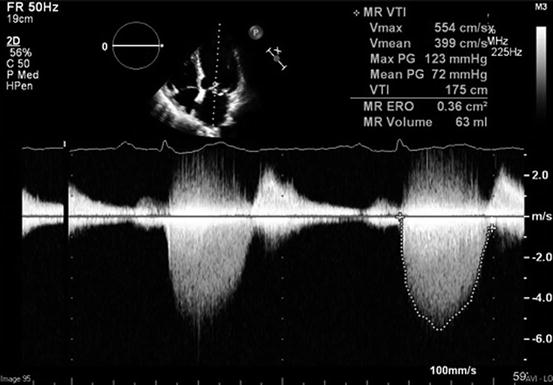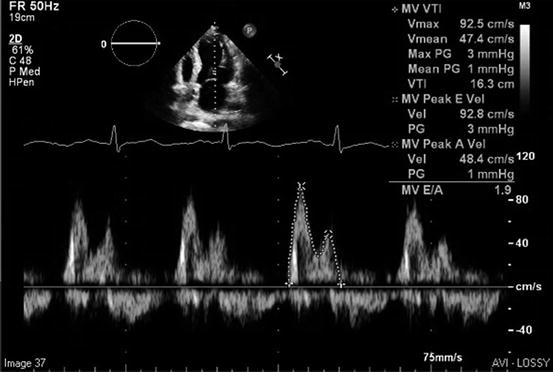Fig. 55.1 Color flow Doppler imaging of mitral valve regurgitation from the transesophageal echocardiographic Four-chamber mid-esophageal view with zoom-in on the mitral valve. Vena contracta (black double arrow) and proximal isovelocity surface area radius (the distance between the “+” signs) are shown

Fig. 55.2 Continuous wave Doppler sampled across the mitral valve

Fig. 55.3 Pulsed wave Doppler sampled at the mitral valve
Answers
- 1.
The figures show still echocardiographic frames for a patient with mitral valve regurgitation. Figure 55.1 is color flow Doppler with transesophageal echocardiography, and Figs. 55.2 and 55.3 demonstrate continuous wave Doppler sampled across the mitral valve and pulsed wave Doppler sampled at the mitral valve using transthoracic echocardiography (TTE).
- 2.
Color flow Doppler displays intracavity blood flow in colors (red, blue, green, or their combinations) depending on the velocity, direction, and extent of turbulence [1]. Color flow Doppler is a widely used method for the detection of regurgitant valvular heart disease. This technique provides visualization of the origin and width (vena contracta) of the regurgitation jet, spatial orientation of the jet area in the receiving chamber, and flow convergence into the regurgitant orifice [2]. The area of the regurgitant jet can provide a rapid quantitative assessment of the severity of the regurgitation; generally speaking, a large area may indicate a more significant regurgitation [2]. Vena contracta or regurgitant jet width (black double arrow in Fig. 55.1) is the narrowest portion of a jet that occurs at/or just downstream from the orifice of the valve, and it is an indirect measure of the regurgitant orifice [3]. Proximal isovelocity surface area (PISA) or flow convergence is another method to quantify the severity of mitral valve regurgitation. It is based on the continuity equation and the principle of flow conversation [1, 2]. As blood in the left ventricle approaches the mitral regurgitant orifice, there is convergence and flow acceleration. This is seen in hemispheric waves of decreasing area but of equal velocity (hence, the term isovelocity) [1, 2]. PISA is identified by color flow Doppler as the “red-blue” aliasing interface (PISA radius is the distance between the “+” signs in Fig. 55.1). PISA radius is used to calculate the effective regurgitant orifice area (ERO), which is the cross-sectional area of the vena contracta, and regurgitant volume (which is the volume of the blood that is leaking back to the left atrium during systole) [1]. ERO and the regurgitant volume can also be calculated using the volumetric method [1]. In the absence of significant aortic valve regurgitation, the regurgitant volume is equal to the flow across the mitral valve minus the flow across the left ventricular outflow tract (systemic stroke volume) [1]. These calculations are made by obtaining the LVOT and mitral valve diameters and LVOT and mitral valve time-velocity integral (TVI) [1]. Figure 55.3 shows pulsed wave Doppler at the mitral valve which depicts the TVI of the mitral valve.
Full access? Get Clinical Tree




